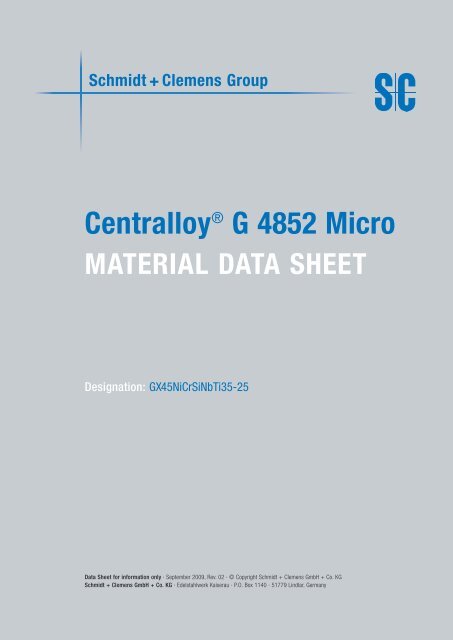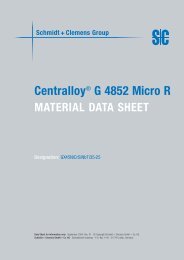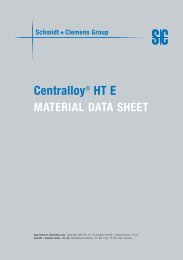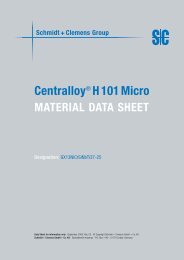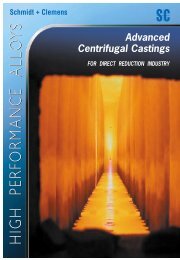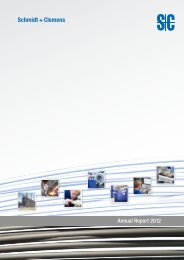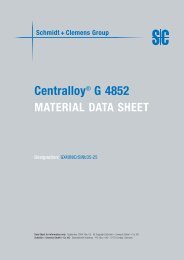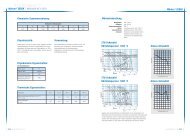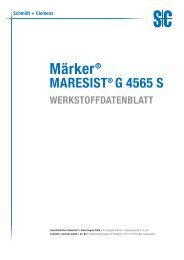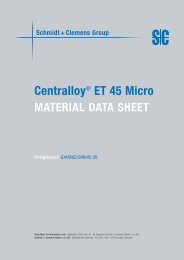Centralloy® G 4852 Micro - Schmidt+Clemens
Centralloy® G 4852 Micro - Schmidt+Clemens
Centralloy® G 4852 Micro - Schmidt+Clemens
Create successful ePaper yourself
Turn your PDF publications into a flip-book with our unique Google optimized e-Paper software.
Schmidt + Clemens Group<br />
Centralloy ® G <strong>4852</strong> <strong>Micro</strong><br />
material data sheet<br />
Designation: GX45NiCrSiNbTi35-25<br />
Data Sheet for information only · September 2009, Rev. 02 · © Copyright Schmidt + Clemens GmbH + Co. KG<br />
Schmidt + Clemens GmbH + Co. KG · Edelstahlwerk Kaiserau · P.O. Box 1140 · 51779 Lindlar, Germany
Centralloy ® G <strong>4852</strong> <strong>Micro</strong><br />
Contents:<br />
Features, Product Forms,<br />
Chemical Composition, Applications ................ 2<br />
Physical Properties . ........................... 3<br />
Mechanical Properties ......................... 4<br />
Carburisation, Oxidation Resistance ................ 5<br />
Parametric Stress Rupture Strength ................ 6<br />
Parametric Minimum Creep Rate,<br />
Manufacturing Characteristics,<br />
Health and Safety Information .................... 7<br />
Contact Information ........................... 8<br />
Features<br />
Centralloy ® G <strong>4852</strong> <strong>Micro</strong> is a cast austenitic steel with 35%<br />
nickel, 25% chromium plus niobium, titanium and others. The<br />
alloy possesses excellent structural stability, very good high<br />
temperature stress rupture strength and good carburisation/<br />
oxidation resistance.<br />
The presence of carbon leads to the formation of a series of<br />
carbides:<br />
a) Intergranularly occuring primary carbides, nitrides or carbonitrides<br />
of the general form M(C,N) where M is usually niobium<br />
and titanium. These greatly affect the generation of good high<br />
temperature properties. The phase is visible in unetched micro<br />
specimens, its color varying from the orange/yellow of the<br />
nitride to the grey/mauve of the carbide.<br />
b) Chromium-rich intergranular carbides of the M 7<br />
C 3<br />
and M 23<br />
C 6<br />
types. These carbides have a profound influence on properties<br />
due to decomposition and re-precipitation reactions in service<br />
producing secondary carbides in a rather uniform dispersion.<br />
By this mechanism dislocation movement is impeded with the<br />
result of significant strengthening at elevated temperatures.<br />
Product Forms<br />
Centralloy ® G <strong>4852</strong> <strong>Micro</strong> was designed as centrispun tube<br />
material to meet specific design criteria in terms of carburisation<br />
and oxidation resistance, creep rupture strength and weldability.<br />
It is available as centrispun tubes, statically cast and investment<br />
cast product forms.<br />
Other forms may be supplied upon request. Further information<br />
regarding these topics, and maximum and minimum sizes, may<br />
be obtained from the sales department.<br />
Chemical Composition (*) mass percentage<br />
Carbon .....................................0.45<br />
Silicon ..................................... 1.50<br />
Manganese ..................................1.00<br />
Chromium ..................................25.00<br />
Nickel .....................................35.00<br />
Niobium .....................................1.50<br />
Titanium ................................ Additions<br />
Iron .....................................Balance<br />
(*) This is a typical composition which may be slightly modified<br />
according to the application.<br />
Applications<br />
Tubular systems requiring very high creep rupture strength combined<br />
with good oxidation and carburisation resistance. No heat<br />
treatment is required for most applications of this alloy. Main high<br />
temperature applications for the material are:<br />
Process: max. operating temperature, °C<br />
Steam cracking ..............................1130<br />
Steam reforming ..............................1130<br />
Direct reduction of iron ore ......................1130<br />
2<br />
Centralloy ® G <strong>4852</strong> <strong>Micro</strong> GX45NiCrSiNbTi35-25
Physical Properties<br />
Density: 8.0 g/cm 3<br />
Thermal Conductivity (20°C): 14.6 W/mK<br />
19.0<br />
Mean Coefficient of Linear Thermal Expansion<br />
Coefficient of Thermal Expansion, 10 -6 /K<br />
18.5<br />
18.0<br />
17.5<br />
17.0<br />
16.5<br />
16.0<br />
15.5<br />
15.0<br />
0 100 200 300 400 500 600 700 800 900 1000<br />
Temperature, °C<br />
170<br />
Young‘s Modulus of Elasticity<br />
160<br />
150<br />
Young‘s Modulus, GPa<br />
140<br />
130<br />
120<br />
110<br />
temperature, ϒC<br />
100<br />
90<br />
0 100 200 300 400 500 600 700 800 900 1000 1100<br />
Temperature, °C<br />
GX45NiCrSiNbTi35-25 Centralloy ® G <strong>4852</strong> <strong>Micro</strong><br />
3
Centralloy ® G <strong>4852</strong> <strong>Micro</strong><br />
Mechanical Properties<br />
(only for wall thickness less than 25 mm in the as cast condition)<br />
Tensile properties<br />
Minimum tensile properties at 20°C: 0.2% Yield strength: 230 MPa<br />
Ultimate tensile strength: 470 MPa<br />
Elongation (l = 5d):<br />
8% for centricast tubes<br />
6% for static castings<br />
19.0<br />
18.5<br />
18.0<br />
17.5<br />
17.0<br />
16.5<br />
16.0<br />
15.5<br />
Strength, MPa<br />
550<br />
500<br />
450<br />
400<br />
350<br />
300<br />
250<br />
200<br />
150<br />
100<br />
50<br />
Typical Tensile Strength and 0.2% Yield Strength vs. Temperature<br />
Ultimate Tensile Strength<br />
0.2% Yield Strength<br />
15.0<br />
0<br />
0 100 200 300 400 500 600 700 800 900 1000<br />
Temperature, °C<br />
Typical Tensile Test Elongation vs. Temperature<br />
50<br />
45<br />
40<br />
Elongation (l=5d), %<br />
35<br />
30<br />
25<br />
20<br />
15<br />
10<br />
temperature, ϒC<br />
5<br />
0<br />
0 100 200 300 400 500 600 700 800 900 1000 1100<br />
Temperature, °C<br />
4<br />
Centralloy ® G <strong>4852</strong> <strong>Micro</strong> GX45NiCrSiNbTi35-25
Carburisation Resistance<br />
2.0<br />
Increase in Carbon Content vs. Temperature after Pack Carburisation<br />
for 260 Hours at Indicated Test Temperature<br />
1.5<br />
Carbon Increase, %<br />
1.0<br />
0.5<br />
0.0<br />
1000 1025 1050 1075 1100 1125 1150<br />
Temperature, °C<br />
Oxidation Resistance<br />
Temperature, ϒC<br />
35<br />
30<br />
Oxidation Weight Loss vs. Temperature for 10 Thermal Cycles in Air<br />
Between Indicated Temperature and Room Temperature<br />
7 hours hold time per cycle at test temperature<br />
25<br />
Weight Loss, mg/cm 2<br />
20<br />
15<br />
10<br />
5<br />
0<br />
1000 1025 1050 1075 1100 1125 1150 1175<br />
1200<br />
Temperature, °C<br />
GX45NiCrSiNbTi35-25 Centralloy ® G <strong>4852</strong> <strong>Micro</strong><br />
5
Centralloy ® G <strong>4852</strong> <strong>Micro</strong><br />
Parametric Stress Rupture Strength<br />
100<br />
10<br />
1<br />
31<br />
Parametric Stress Rupture<br />
Average<br />
Lower Scatter Band<br />
LMP = Larson Miller Parameter<br />
LMP = T (22.9 + log tr)/1000<br />
Where T: temperature [K] and tr: rupture time [h]<br />
Lower Scatter Band represents 95% confidence level<br />
32 33 34 35 36 37 38 39 40<br />
LMP<br />
Initial Stress, MPa<br />
6<br />
Centralloy ® G <strong>4852</strong> <strong>Micro</strong> GX45NiCrSiNbTi35-25
Parametric Minimum Creep Rate<br />
P= (T+273) (20-log[min. creep rate in % per hour])/1000<br />
33.5<br />
33.0<br />
32.5<br />
32.0<br />
31.5<br />
31.0<br />
30.5<br />
30.0<br />
9 10 11 12 13 14 15 16<br />
17<br />
Initial Stress, MPa<br />
Manufacturing Characteristics<br />
Machining<br />
temperature, ϒC<br />
In general terms the machinability of Centralloy ® G <strong>4852</strong> <strong>Micro</strong> is<br />
similar to that of other heat resistant alloys.<br />
Welding<br />
For critical, highly stressed and corrosion resistant joints coated<br />
electrodes, flux cored wire and bare filler material are commercially<br />
available. These welding consumables have high<br />
strength properties at elevated temperatures with good retained<br />
ductilities. Besides fillerless PAW, TIG and MAW have been used<br />
satisfactorily for component fabrication or repair welding. Preheating<br />
and postweld heat treatment of the joint is not necessary.<br />
For dissimilar weld joints to austenitic materials the same filler<br />
materials are recommended. Further information will be supplied<br />
upon request.<br />
Health and Safety Information<br />
The operation and maintenance of welding equipment should<br />
conform to the provisions of relevant national standards for the<br />
protection of personnel.<br />
Mechanical ventilation is advisable and, under certain conditions<br />
in confined spaces, is necessary during welding operations in<br />
order to prevent possible exposure to hazardous fumes, gases or<br />
dust that may occur.<br />
Nickel- and iron-base materials may contain, in varying concentrations,<br />
elemental constitutions of chromium, iron, manganese,<br />
molybdenum, cobalt, nickel, tungsten and aluminium. Inhalation<br />
of metal dust from welding, grinding, melting and dross handling<br />
of these alloy systems may cause adverse health effects.<br />
The information in this publication is as complete and accurate as possible at the time of publication. Variations in properties can occur to production and process routes.<br />
However, no warranty or any legal liability for its accuracy, completeness and results to be obtained for any particular use of the information herein contained is given. Where<br />
possible the test conditions are fully described. Where reference, is made to the balance of the alloy’s composition it is not guaranteed that this balance is composed exclusively<br />
of the element mentioned, but that it predominates and others are present only in minimal quantities. The creep rupture data are frequently insufficient to be directly<br />
translatable to specific design or performance applications without examination and verification of their applicability and suitability by professionally qualified personnel. The<br />
primary units for property data are based on those of the SI-system.<br />
GX45NiCrSiNbTi35-25 Centralloy ® G <strong>4852</strong> <strong>Micro</strong><br />
7
Schmidt + Clemens Group<br />
Spun Casting – Petrochemical Industry<br />
Industries<br />
• Petrochemicals<br />
• Iron-ore direct reduction<br />
Germany<br />
Schmidt + Clemens GmbH + Co. KG<br />
Edelstahlwerk Kaiserau<br />
Kaiserau 2, 51789 Lindlar<br />
Phone: +49 2266 920<br />
Fax: +49 2266 92370<br />
E-Mail: info@schmidt-clemens.com<br />
Spain<br />
Schmidt - Clemens Spain S.A.U.<br />
Ctra. Estella-Vitoria, Km. 12<br />
31280 Murieta, Navarra<br />
Phone: +34 948 53 46 00<br />
Fax: +34 948 53 46 01<br />
E-Mail: centracero@schmidt-clemens.com<br />
Services<br />
• Business consulting<br />
• Analysis of operational data<br />
• Training of customer personnel<br />
• Welding supervision<br />
Brazil<br />
Schmidt + Clemens Brasil Ltda.<br />
Avenida Beta, 351<br />
13213-070, Jundiaí, Sao Paulo<br />
Phone: +55 11 3378 3901<br />
Fax: +55 11 4582 9888<br />
E-Mail: scbrasil@schmidt-clemens.com.br<br />
USA<br />
Schmidt & Clemens Inc.<br />
24 Greenway Plaza Suite 1840<br />
Houston, Texas 77046<br />
Phone: +1 713 629 7770<br />
Fax: +1 713 629 7373<br />
E-Mail: sales-us@schmidt-clemens.com<br />
Malaysia<br />
Schmidt + Clemens (Asia) Sdn. Bhd.<br />
No. 15, Jalan Pemaju U1/15, Section U1<br />
Hicom Glenmarie Industrial Park<br />
40150 Shah Alam, Selangor Darul Ehsan<br />
Phone: +60 3 5569 1945<br />
Fax: +60 3 5569 1425<br />
E-Mail: sc-asia@schmidt-clemens.com<br />
United Arab Emirates<br />
Schmidt + Clemens Middle East DMCC<br />
10 E, 10 th Floor, Silver (AG) Tower<br />
Jumeirah Lake Tower, Dubai<br />
Phone: +971 4 4328385<br />
Fax: +971 4 4328384<br />
E-Mail: dubai@schmidt-clemens.com<br />
Czech Republic<br />
S+C Alfanametal s.r.o koncern<br />
783 57 Tršice c. 126<br />
Phone: +420 58 59 57 428<br />
Fax: +420 58 59 57 430<br />
E-Mail: alfa@alfanametal.cz<br />
India<br />
Schmidt + Clemens GmbH + Co. KG<br />
India Liaison Office<br />
A 214 Mahindra Gardens, S.V. Road<br />
Goregaon (W), Mumbai 400 062<br />
Phone: +91 22 8748 445<br />
Fax: +91 22 8791 226<br />
E-Mail: scindia@vsnl.net<br />
www.schmidt-clemens.com<br />
Production<br />
Sales Company


